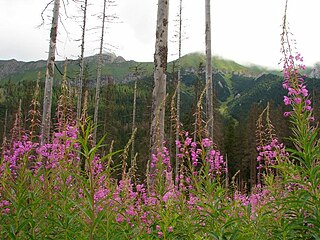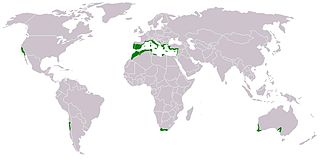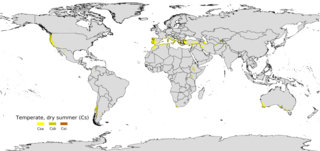
Matorral is a Spanish word, along with tomillares, for shrubland, thicket or bushes. [1] It is used in naming and describing a Mediterranean climate ecosystem in Southern Europe.

Matorral is a Spanish word, along with tomillares, for shrubland, thicket or bushes. [1] It is used in naming and describing a Mediterranean climate ecosystem in Southern Europe.
Matorral originally referred to the Matorral shrublands and woodlands in the Mediterranean climate regions of Spain and other Mediterranean Basin countries. These scrub shrublands and woodlands are a plant community and a distinct habitat. Other common general names for this Mediterranean region shrubland habitat ecosystem are: in France as Maquis and Garrigue ; in Italy as Macchia Mediterranea; in Greece as Phrygana; in Portugal as Mato; and in Israel as Batha. Now the term is used more broadly to include similar bio-assemblages where ever they occur.
In Portugal, the term mato or matagal is used to refer to the scrublands, or heaths, that formed on the Cambrian and Silurian schists in the north and central parts of Portugal.
Mediterranean Matorral shrublands are often part of a mosaic landscape, interspersed with forests, woodlands, grassland, and scrublands. [2] [3]
The term matorral followed Spanish colonization of the Americas, and is used to refer to both Mediterranean (climate) woodlands and scrub, [4] and xeric shrublands ecosystems in Mexico, [5] Chile, [4] and elsewhere.
There are Chilean Matorral areas in central Chile, including portions of La Campana National Park.
The Central Mexican matorral, Meseta Central matorral, Tamaulipan matorral, and Tehuacán Valley matorral are xeric shrubland ecoregions of Mexico.
The Portuguese term mato was imported to colonial eastern South America, where it was used to refer to the great scrublands, savannas, and flooded grasslands region called the Mato Grosso, in present-day western Brazil.
The regional Mexican band Los Tigres Del Norte used the term matorrales, the plural form of matorral, in their now-famous song "Pacas De A Kilo," an example of the infamous narco-corridos or drug ballads.

A biome is a biogeographical unit consisting of a biological community that has formed in response to the physical environment in which they are found and a shared regional climate. Biomes may span more than one continent. Biome is a broader term than habitat and can comprise a variety of habitats.

Chaparral is a shrubland plant community and geographical feature found primarily in the U.S. state of California, in southern Oregon, and in the northern portion of the Baja California Peninsula in Mexico. It is shaped by a Mediterranean climate and infrequent, high-intensity crown fires. Chaparral features summer-drought-tolerant plants with hard sclerophyllous evergreen leaves, as contrasted with the associated soft-leaved, drought-deciduous, scrub community of coastal sage scrub, found often on drier, southern facing slopes within the chaparral biome. Three other closely related chaparral shrubland systems occur in central Arizona, western Texas, and along the eastern side of central Mexico's mountain chains (mexical), all having summer rains in contrast to the Mediterranean climate of other chaparral formations. Chaparral comprises 9% of California's wildland vegetation and contains 20% of its plant species. The name comes from the Spanish word chaparro, which translates to "place of the scrub oak".

A woodland is, in the broad sense, land covered with trees, or in a narrow sense, synonymous with wood, a low-density forest forming open habitats with plenty of sunlight and limited shade. Woodlands may support an understory of shrubs and herbaceous plants including grasses. Woodland may form a transition to shrubland under drier conditions or during early stages of primary or secondary succession. Higher-density areas of trees with a largely closed canopy that provides extensive and nearly continuous shade are often referred to as forests.

Sclerophyll is a type of vegetation that is adapted to long periods of dryness and heat. The plants feature hard leaves, short internodes and leaf orientation which is parallel or oblique to direct sunlight. The word comes from the Greek sklēros (hard) and phyllon (leaf). The term was coined by A.F.W. Schimper in 1898, originally as a synonym of xeromorph, but the two words were later differentiated.
The Global 200 is the list of ecoregions identified by the World Wide Fund for Nature (WWF), the global conservation organization, as priorities for conservation. According to WWF, an ecoregion is defined as a "relatively large unit of land or water containing a characteristic set of natural communities that share a large majority of their species dynamics, and environmental conditions". For example, based on their levels of endemism, Madagascar gets multiple listings, ancient Lake Baikal gets one, and the North American Great Lakes get none.

Deserts and xeric shrublands are a biome defined by the World Wide Fund for Nature. Deserts and xeric shrublands form the largest terrestrial biome, covering 19% of Earth's land surface area. Ecoregions in this habitat type vary greatly in the amount of annual rainfall they receive, usually less than 250 millimetres (10 in) annually except in the margins. Generally evaporation exceeds rainfall in these ecoregions. Temperature variability is also diverse in these lands. Many deserts, such as the Sahara, are hot year-round, but others, such as East Asia's Gobi, become quite cold in winter.

Maquis or macchia is a shrubland biome in the Mediterranean region, typically consisting of densely growing evergreen shrubs.

A Mediterranean climate, also called dry summer temperate climateCs, is a temperate climate sub-type, characterized by dry summers and mild, wet winters. The climate receives its name from the Mediterranean Basin, where this climate type is most common. Mediterranean climate zones are typically located along the western coasts of continents, between roughly 30 and 45 degrees north and south of the equator. The main cause of Mediterranean, or dry summer climate, is the subtropical ridge which extends toward that hemisphere's pole during the summer and migrates toward the equator during the winter due to the seasonal poleward-equatorward variations of temperatures.

A heath is a shrubland habitat found mainly on free-draining infertile, acidic soils and characterised by open, low-growing woody vegetation. Moorland is generally related to high-ground heaths with—especially in Great Britain—a cooler and damper climate.

Southwest Australia is a biogeographic region in Western Australia. It includes the Mediterranean-climate area of southwestern Australia, which is home to a diverse and distinctive flora and fauna.

Shrubland, scrubland, scrub, brush, or bush is a plant community characterized by vegetation dominated by shrubs, often also including grasses, herbs, and geophytes. Shrubland may either occur naturally or be the result of human activity. It may be the mature vegetation type in a particular region and remain stable over time, or a transitional community that occurs temporarily as the result of a disturbance, such as fire. A stable state may be maintained by regular natural disturbance such as fire or browsing. Shrubland may be unsuitable for human habitation because of the danger of fire. The term was coined in 1903.

In biogeography, the Mediterranean Basin is the region of lands around the Mediterranean Sea that have mostly a Mediterranean climate, with mild to cool, rainy winters and warm to hot, dry summers, which supports characteristic Mediterranean forests, woodlands, and scrub vegetation.

Garrigue or garigue, also known as phrygana, is a type of low scrubland ecoregion and plant community in the Mediterranean forests, woodlands, and scrub biome.

The Tehuacán Valley matorral is a xeric shrubland ecoregion, of the deserts and xeric shrublands biome, located in eastern Central Mexico.

The Chilean Matorral (NT1201) is a terrestrial ecoregion of central Chile, located on the west coast of South America. It is in the Mediterranean forests, woodlands, and scrub biome, part of the Neotropical realm.

The Coolgardie woodlands is an ecoregion in southern Western Australia. The predominant vegetation is woodlands and mallee scrub. The ecoregion is a transitional zone between the Mediterranean-climate forests, woodlands, and shrublands of Southwest Australia and the deserts and dry scrublands of the Australian interior.

A thorn forest is a dense scrubland with vegetation characteristic of dry subtropical and warm temperate areas with a seasonal rainfall averaging 250 to 500 mm.

Mediterranean forests, woodlands, and scrub is a biome defined by the World Wide Fund for Nature. The biome is generally characterized by dry summers and rainy winters, although in some areas rainfall may be uniform. Summers are typically hot in low-lying inland locations but can be cool near colder seas. Winters are typically mild to cool in low-lying locations but can be cold in inland and higher locations. All these ecoregions are highly distinctive, collectively harboring 10% of the Earth's plant species.

The Northeastern Spain and Southern France Mediterranean forests is a Mediterranean forests, woodlands, and scrub ecoregion in southwestern Europe. It occupies the Mediterranean coastal region of northeastern Spain and Southern France, and the Balearic Islands.